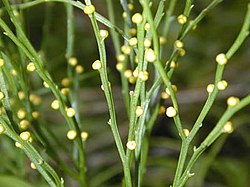Psilotum nudum
| Psilotum | |
|---|---|

| |
| Closeup of Psilotum nudum | |
| Scientific classification | |
| Kingdom: | |
| Division: | |
| Class: | |
| Order: | |
| Family: | |
| Genus: | |
| Species: | Psilotum nudum
|
Psilotum nudum is a fern plant. Like the other species in the order Psilotales, it lacks roots. It is found in tropical Africa, Central America, tropical and subtropical North America, South America,[1], tropical Asia, Australia, Hawaii, southern Japan, Lord Howe Island, New Zealand, with a few isolated populations in SW Europe ("Los Alcornocales", Spain, Cádiz province). [2] [3]
Psilotum nudum, known as the Skeleton Fork Fern is considered a "primitive" plant - a descendent of possibly the first group of vascular plants which were widespread during the Devonian and Silurian periods. Its name, Psilotum nudum, means "bare naked" in Latin, because it lacks most of the organs of modern plants.
In tropical areas, this plant is often epiphytic, whilst in more temperate areas, such as south-eastern Australia, it is usually found growing in rock crevices.[3] Thousands of people per day walk by these plants at the Sydney Opera House forecourt.[4]
Cultivation and uses
The plant, which grows wild in southern Japan, was once much cultivated in Japanese gardens as an ornamental plant. Slightly over 100 garden varieties were given fantastic names.[5] Called Matsubaran (pine needle orchid) in Japanese, it was one of the noble plants in the Edo Period (1603-1867).
The species is naturally found on all the main Hawaiian Islands. Known locally as Moa because of its chicken feet like stems, the Hawaiians collected large quantities of the spores and used them like talcum powder,[6] under the loincloth to prevent chafing. The spores were also used medicinally as a purge. Children would play a game called ‘moa nahele’ or cock fighting with the branch stems. Twigs of the Moa were interlocked and the players pulled on the ends. The loser's twig broke and the winner crowed like a rooster.[7] The species is still often used in making traditional Hawaiian leis.
Its common name, Whisk Fern, alludes to its use in the past as a small broom, made by tying a handful of its branches together.[8] It is sometimes found in cultivation (either accidentally, as a weed in greenhouses, or deliberately, in the form of a number of cultivars).[1]

It may prove to be a good source of antimicrobial chemicals.[9]
References
- ^ a b "Psilotum nudum". Flora of North America.
- ^ "Psilotum nudum" (PDF). Atlas y Libro Rojo de la Flora Vascular Amenazada de España (in Spanish).
- ^ a b Fairley, Alan; Moore, Philip (1989), Native plants of the Sydney district (1st ed.), Kangaroo Press, p. 27, ISBN 0-86417-261-3
- ^ Les Robinson - Field Guide to the Native Plants of Sydney, ISBN 978-0-7318-1211-0 page 303
- ^ Rouffa, A. (1971) "An Appendageless Psilotum. Introduction to Aerial Shoot Morphology." American Fern Society 61(2), 75-86
- ^ Carr, G. "Psilotaceae". University of Hawai`i at Manoa. Retrieved 1 April 2010.
- ^ Hawaiian-English Dictionary. University of Hawai‘i Press. 1986. p. 248.
{{cite book}}: Unknown parameter|coauthors=ignored (|author=suggested) (help) - ^ Ombrello, T. "Psilotum". Union County College Biology Department. Retrieved 1 April 2010.
- ^ Rani D, Khare PB, Dantu PK"In Vitro Antibacterial and Antifungal Properties of Aqueous and Non-Aqueous Frond Extracts of Psilotum nudum, Nephrolepis biserrata and Nephrolepis cordifolia." Indian J Pharm Sci. 2010 Nov;72(6):818-22
